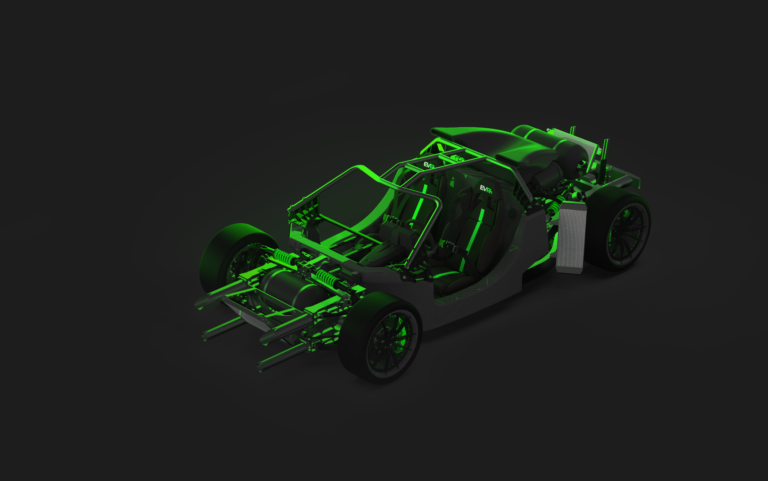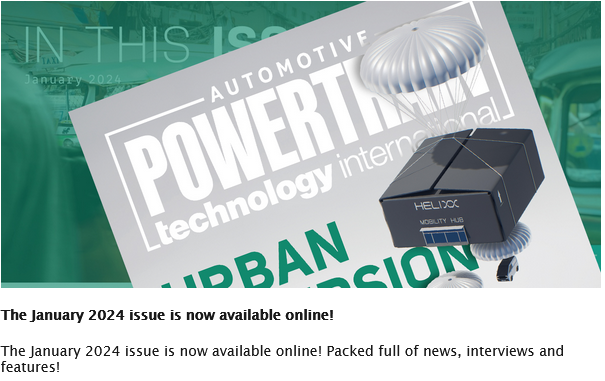In 2022, UK-based WAE, now owned by the Fortescue mining concern, debuted its EVR concept – a modular high-performance BEV platform (see Flexible performer, September 2022, p14*) intended to provide vehicle manufacturers with a flexible basis for sporting EVs. Now, the company has taken the concept a step further with the EVRh, a version equipped with a fuel cell.
Development of the FCEV variant began around six months after the pure BEV. “We have used the EVRh as a testbed to get involved in more hydrogen systems,” says Sam Dew, project engineer at WAE. The company sourced the fuel cell from Intelligent Energy, because it aims to gain experience of the integration challenges rather than becoming a fuel cell developer. “Looking at the battery technology and how we can best utilize our experience specifically in hydrogen vehicles, there are some quite unique challenges and it is not just the same as a BEV,” notes Dew. These differences are not simply in the control strategies used but also in the battery chemistry and structure.
Being the EVR, we are looking at Nürburgring-type applications and to achieve that we were going to need a reasonable-size battery pack
Sam Dew, project engineer at WAE
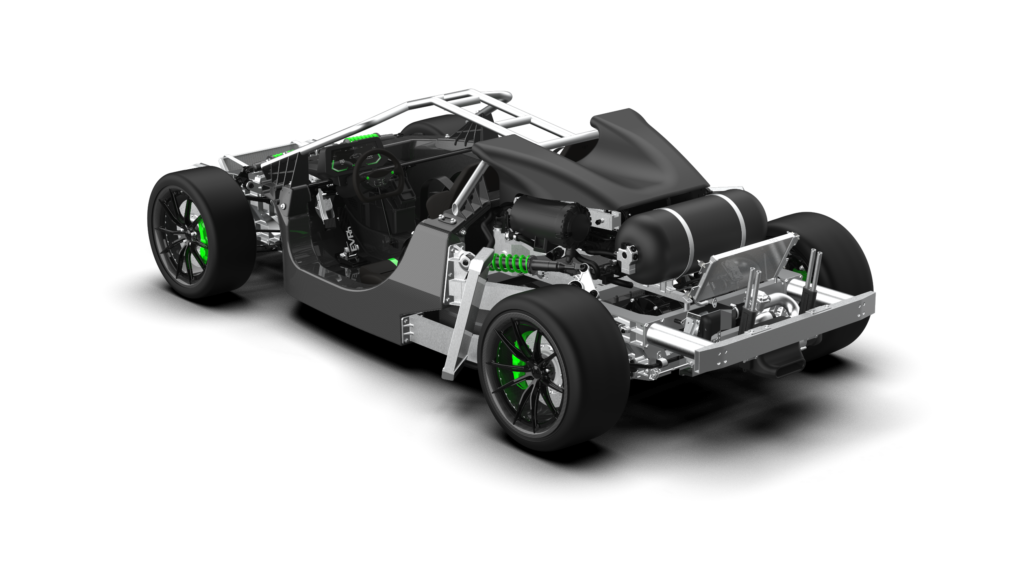
Right sizing
The battery pack acts as a buffer for the fuel cell (which has an output of 120kW) and enables a 550kW maximum power output of the entire powertrain. “Being the EVR, we are looking at Nürburgring-type applications and to achieve that we were going to need a reasonable-size battery pack,” notes Dew. The battery therefore delivers the lion’s share of power, peaking at 430kW.
“Most fuel cells being used in passenger vehicles have peak power figures of 90-110kW,” he continues. “Anything larger becomes difficult to package and you are starting to get into truck territory. We knew that would be the output range of the fuel cell regardless of which supplier we went with. From there we had to size the battery to achieve the power level we were happy with and gave suitable power figures.”
The battery is closely related to that used in the EVR BEV and features a very similar installation within the vehicle. “The difference is we have effectively chopped it in half,” observes Dew. This has seen capacity drop from 80kWh to 40kWh, though it still operates at 800V. The reduction in the capacity of the pack reduced its height sufficiently to allow for the fuel cell to be sited on top of the battery.
The hydrogen capacity packaged on board the vehicle is around 4kg split across two tanks, one in the rear chassis, the second at the front in the location previously occupied by a motor in the pure BEV EVR. “That capacity is achieved with two 700-bar tanks, which is somewhat on the edge of current technology. But being an R&D vehicle, and a high-performance one, being able to pack as much energy into as small a space as possible, while optimizing the mass, was key for us,” says Dew. WAE has worked with a partner for the supply of the tanks on the demonstrator vehicle, but has also been conducting in-house R&D using its own composites knowledge for potential future developments.
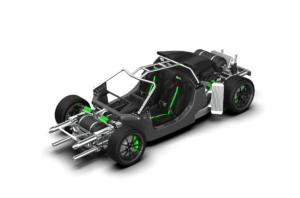 The EVRh tips the scales at between 1,800kg and 1,900kg depending on the exact configuration of the drivetrain. “The mass depends on whether you want four- or two-wheel drive,” states Dew. He also highlights that the impact of the fuel tanks on overall weight distribution cannot be ignored. “Even if they are carbon-fiber tanks, they are quite heavy and it has been a challenge to fit those in. There has been some work done by other companies on conformable tanks and we think those will open more packaging options in the future, which we are exploring.”
The EVRh tips the scales at between 1,800kg and 1,900kg depending on the exact configuration of the drivetrain. “The mass depends on whether you want four- or two-wheel drive,” states Dew. He also highlights that the impact of the fuel tanks on overall weight distribution cannot be ignored. “Even if they are carbon-fiber tanks, they are quite heavy and it has been a challenge to fit those in. There has been some work done by other companies on conformable tanks and we think those will open more packaging options in the future, which we are exploring.”
Across a representative drive cycle, Dew says the range of the EVRh should be in the region of 600km, an improvement on the BEV variant. “If you were to take a less performance-oriented view on the vehicle, take away some of the extreme power capabilities in the battery and replace it with a more energy-focused battery, wind down the [motor] power a bit, we could certainly extend that range further,” he explains.
Energy balancing
“This is technically a plug-in hybrid setup, rather than some other mainstream hydrogen vehicles that use a very small battery, more like a mild hybrid,” outlines Dew. In addition to being able to fuel the hydrogen tanks, the EVRh can be charged when stationary. “The reason we went down that route was because we have such a large battery. If you were out on a track day, for example, or doing some spirited driving, we wanted you to be in a position where you could use a fast charger and get the battery power back as quickly as possible.” The fuel cell can also charge the battery when the vehicle is stationary, and excess power from the fuelcell can be directed to the battery when cruising, as can energy from regenerative braking. 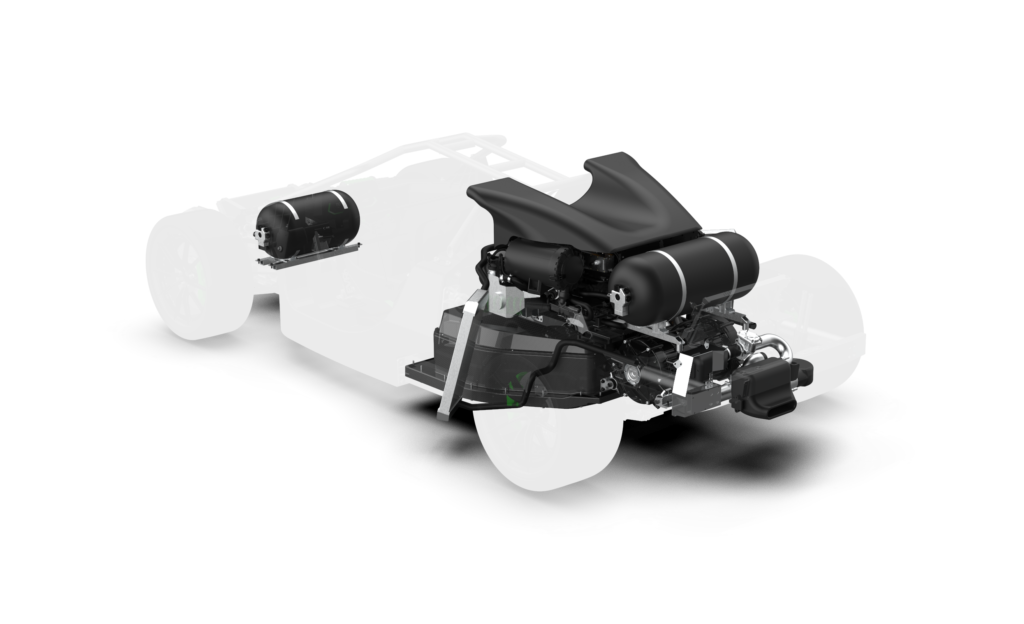 Compared with a BEV, these interactions introduce an extra layer of complexity when it comes to energy management, and this balancing is handled by a single VCU. “We do have our vehicle control module that’s been developed [in-house] primarily for BEV vehicles so we are now seeing how we can use that, and the software that we’ve got, in order to actually find the optimal balance between these systems,” explains Dew.
Compared with a BEV, these interactions introduce an extra layer of complexity when it comes to energy management, and this balancing is handled by a single VCU. “We do have our vehicle control module that’s been developed [in-house] primarily for BEV vehicles so we are now seeing how we can use that, and the software that we’ve got, in order to actually find the optimal balance between these systems,” explains Dew.
The fuel cell also has more complex cooling demands than a pure BEV, reflected in the thermal management systems. “EVR started out as a BEV with the fuel cell integration retrospectively, and one of the key visual differences is the addition of two radiators we have either side, dedicated to the fuel cell,” notes Dew, adding that there is a considerably greater cooling demand for the fuel cell compared with a BEV. “From an overall vehicle integration and aerodynamics perspective, that makes it more challenging. You are almost getting back into ICE territory, which means there is a different [aerodynamic] efficiency challenge with fuel cells.”
Though WAE brought in the fuel cell stack from outside, its integration efforts have touched on the balance of plant. “The integration challenges around EVRh have really given us an opportunity to look at all
of that and how to better package the balance of plant and the stack itself,” says Dew, “and that is an avenue we are looking at for future R&D.”
The EVRh is very much a testbed. According to Dew, “We see this as an opportunity to use the platform we’ve got to develop these systems, and then ultimately trickle down that technology into more mainstream applications, which more than likely will move away from passenger vehicles into larger vehicles and possibly even stationary applications.”

